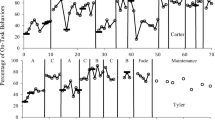Abstract
The measurement error of time-sampling observation systems, used to estimate the frequencyof behavioral events, was analyzed by means of a five-factor design, computer simulation experiment. The first three factors represented response parameters: the relative frequency and duration of the behavior and the pattern of response distribution. For each combination of frequency, pattern, and duration, five simulated behavior events were generated within a simulated observation period of 900 sec. A total of 21 different time-sampling systems was employed. As a fourth factor three different observe and record lengths were included (6, 12, and 60 sec). In addition, there were seven different ratios of “observe” to “record” interval length (5∶1, 3∶1, 2∶1, 1∶1, 1∶2, 1∶3, and 1∶5) representing the fifth factor. Thus, 21 time-sampling systems scanned a total of 120 different behavior simulations from 24 types of behavior parameter combinations. The data were analyzed by means of a five-factor (2 × 3 × 4 × 3 × 7) analysis of variance with repeated measures on two factors. The study demonstrated that time sampling leads to high average measurement errors, which are determined by complex interrelationships among a variety of variables. Choosing a time-sampling system arbitrarily may lead to highly erroneous data. It was also shown, however, that time-sampling systems have the potential to yield very accurate results. An empirical selection procedure for time-sampling intervals is proposed to minimize measurement error. Exemplary tables are presented from which time-sampling parameters can be chosen given that the rate, duration, and pattern of occurrence of a behavior to be observed are known.
Similar content being viewed by others
References
Arrington, R. E. (1943). Time sampling in studies of social behavior: A critical review of techniques and results.Psychological Bulletin, 40, 81–124.
Ary, D. (1984). Mathematical explanation of error in duration recording using partial interval, whole interval, and momentary time sampling.Behavioral Assessment, 6, 221–228.
Ary, D., & Suen, H. K. (1983). The use of momentary time sampling to assess both frequency and duration of behavior.Journal of Behavioral Assessment, 5, 143–150.
Green, S. B., McCoy, J. F., Burn, K. P., & Smith, A. C. (1982). Accuracy of observational data with whole interval, partial interval, and momentary time-sampling recording techniques.Journal of Behavioral Assessment, 4, 103–118.
Harries, F. C., & Lahey, B. B. (1982). Recording system bias in direct observational methodology.Clinical Psychology Review, 2, 539–556.
Hartmann, D. P., & Wood, D. D. (1983). Observational methods. In A. S. Bellack, M. Hersen, & A. E. Kazdin (Eds.),International handbook of behavior modification (pp. 109–138). New York: Plenum Press.
Kelly, M. B. (1977). A review of the observational data collection and reliability procedures reported in the Journal of Applied Behavior Analysis.Journal of Applied Behavior Analysis, 10, 97–101.
Milar, C. R., & Hawkins, R. P. (1976). Distorted results from the use of interval recording procedures. In T. A. Brigham, R. P. Hawkins, & J. W. Scott (Eds.),Behavior analysis in education (pp. 261–273). Dubuque, IA: Kendall & Hunt.
Murphy, G., & Goodall, E. (1980). Measurement error in direct observation: A comparison of common recording methods.Behavior Research and Therapy, 18, 147–150.
Powell, J. (1984). On the misrepresentation of behavioral realities by a widely practiced direct observation procedure: Partial interval (one-zero) sampling.Behavioral Assessment, 6, 209–219.
Powell, J., Martindale, A., & Kulp, D. (1975). An evaluation of time-sample measures of behavior.Journal of Applied Behavior Analysis, 8, 436–496.
Powell, J., Martindale, B., Kulp, S., Martindale, A., & Baumann, R. (1977). Taking a closer look: Time sampling and measurement error.Journal of Applied Behavior Analysis, 10, 325–332.
Powell, J., & Rockinson, R. (1978). On the ability of interval time sampling to reflect frequency of occurrence data.Journal of Applied Behavior Analysis, 11, 531–532.
Repp, A. C., Roberts, D. M., Slack, D. J., Repp, C. F., & Berkler, M. S. (1976). A comparison of frequency, interval, and time sampling methods of data collection.Journal of Applied Behavior Analysis, 9, 501–508.
Sanson-Fisher, R. W., Poole, A. D., & Dunn, J. (1980). An empirical method for determining an appropriate interval length for recording behavior.Journal of Applied Behavior Analysis, 13, 493–500.
Author information
Authors and Affiliations
Additional information
The authors thank I. Florin, H. H. Schulze, and G. Sommer for critical readings of early drafts of the manuscript and Marsha Stephens for assistance in developing programs for the computer simulations.
Rights and permissions
About this article
Cite this article
Rojahn, J., Kanoy, R.C. Toward an empirically based parameter selection for time-sampling observation systems. J Psychopathol Behav Assess 7, 99–120 (1985). https://doi.org/10.1007/BF00961077
Accepted:
Issue Date:
DOI: https://doi.org/10.1007/BF00961077




